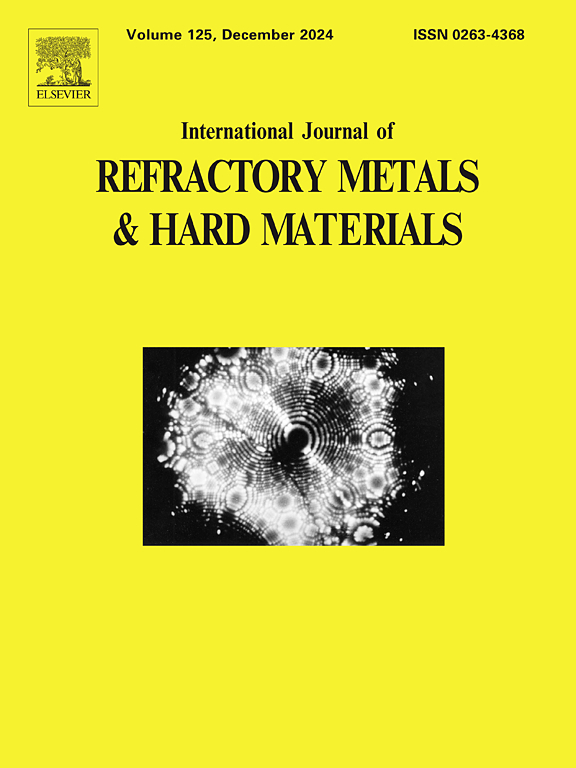Liquid film shearing polishing for high quality and low damage tungsten surface: Process optimization, removal mechanism, and processing defects
IF 4.2
2区 材料科学
Q2 MATERIALS SCIENCE, MULTIDISCIPLINARY
International Journal of Refractory Metals & Hard Materials
Pub Date : 2025-04-14
DOI:10.1016/j.ijrmhm.2025.107189
引用次数: 0
Abstract
Surface quality can directly affect the hydrogen/helium retention behavior of tungsten, which will affect the safety and reliability of nuclear fusion reactors. At present, the polishing of polycrystalline tungsten for fusion reactors mainly has problems such as poor removal uniformity, preferential removal of grain boundaries, and processing defects. In this paper, a novel liquid film shearing polishing (LFSP) method was employed to process polycrystalline tungsten surfaces, which combines the shear rheological effect of non-Newtonian fluid with the strengthening effect of the surface-structured polishing plate. Systematic experiments were conducted to investigate the influence of various process parameters on surface quality, such as liquid film thickness, polishing speed, abrasive size, and abrasive concentration. The optimal polishing parameters were determined as a liquid film thickness of 2 mm, a polishing speed of 110 rpm, an abrasive size of 5 μm, and an abrasive concentration of 4 wt%. The surface morphology and roughness of samples were characterized by scanning electron microscopy and white light interferometry. Combined with surface force analysis, the material removal mechanism of LFSP was further revealed. Results show that the abrasive concentration was the critical factor affecting polishing quality, and the tungsten surface after LFSP was flatter than that after mechanical polishing (MP). Additionally, comparative analysis using transmission electron microscopy and positron annihilation spectroscopy revealed that tungsten polished by LFSP has fewer processing defects than MP. It seems that LFSP has a good application prospect in realizing high quality and low damage polishing of polycrystalline tungsten surface.

高质量低损伤钨表面液膜剪切抛光:工艺优化、去除机理及加工缺陷
表面质量直接影响到钨的氢/氦保留行为,从而影响到核聚变反应堆的安全性和可靠性。目前,用于聚变堆的多晶钨抛光主要存在去除均匀性差、晶界优先去除、加工缺陷等问题。本文采用一种新型的液膜剪切抛光(LFSP)方法,将非牛顿流体的剪切流变效应与表面结构抛光板的强化效应相结合,对多晶钨表面进行了加工。通过系统实验研究了液膜厚度、抛光速度、磨料粒度、磨料浓度等工艺参数对表面质量的影响。优选的抛光参数为液膜厚度为2mm,抛光速度为110 rpm,磨料尺寸为5 μm,磨料浓度为4 wt%。采用扫描电镜和白光干涉法对样品的表面形貌和粗糙度进行了表征。结合表面力分析,进一步揭示了LFSP的材料去除机理。结果表明,磨料浓度是影响抛光质量的关键因素,LFSP抛光后的钨表面比MP抛光后的表面更平整。此外,透射电镜和正电子湮没光谱对比分析表明,LFSP抛光钨的加工缺陷比MP少。LFSP在实现多晶钨表面高质量、低损伤抛光方面具有良好的应用前景。
本文章由计算机程序翻译,如有差异,请以英文原文为准。
求助全文
约1分钟内获得全文
求助全文
来源期刊
CiteScore
7.00
自引率
13.90%
发文量
236
审稿时长
35 days
期刊介绍:
The International Journal of Refractory Metals and Hard Materials (IJRMHM) publishes original research articles concerned with all aspects of refractory metals and hard materials. Refractory metals are defined as metals with melting points higher than 1800 °C. These are tungsten, molybdenum, chromium, tantalum, niobium, hafnium, and rhenium, as well as many compounds and alloys based thereupon. Hard materials that are included in the scope of this journal are defined as materials with hardness values higher than 1000 kg/mm2, primarily intended for applications as manufacturing tools or wear resistant components in mechanical systems. Thus they encompass carbides, nitrides and borides of metals, and related compounds. A special focus of this journal is put on the family of hardmetals, which is also known as cemented tungsten carbide, and cermets which are based on titanium carbide and carbonitrides with or without a metal binder. Ceramics and superhard materials including diamond and cubic boron nitride may also be accepted provided the subject material is presented as hard materials as defined above.

 求助内容:
求助内容: 应助结果提醒方式:
应助结果提醒方式:


